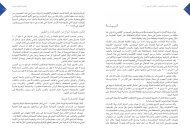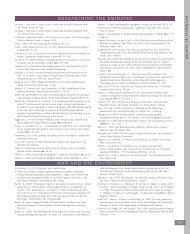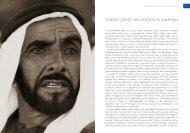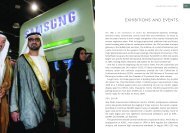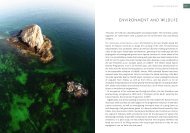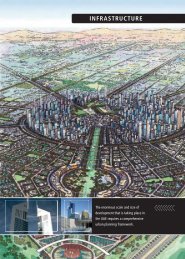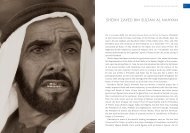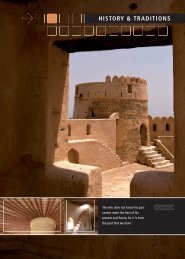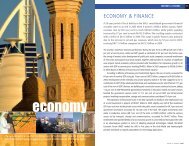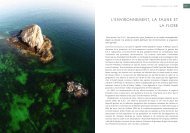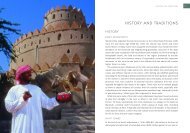You also want an ePaper? Increase the reach of your titles
YUMPU automatically turns print PDFs into web optimized ePapers that Google loves.
126UNITED ARAB EMIRATES YEARBOOK 2006<strong>ECONOMIC</strong> <strong>DEVELOPMENT</strong>127followed by Sharjah with 10.7 trillion cubic feet, Dubai with 4.1 trillion cubic feetand Ra’s al-Khaimah with 1.2 trillion cubic feet.OIL PRODUCTION AND CRUDE RESERVESCrude oil production ceilings are set by OPEC members at regular conferences.The <strong>UAE</strong>’s output of crude oil in 2004 rose in response to increased OPEC quotasthat averaged 2.19 m/bd during the year. Oil industry figures published by OPECindicate that the average production level during the year reached 2.36 mb/d,up from around 2 mb/d in 2003. Abu Dhabi alone produced 1.96 mb/d, comparedto 1.9 mb/d in 2003 and 1.69 mb/d in 2002. At these levels Abu Dhabi had aspare capacity of 500,000 b/d. Recognising the importance of being able to meetdemand surges at short notice, Abu Dhabi has continued to focus on increasing itsproduction capabilities. The target has been to reach around 3 mb/d in 2006 and3.7 mb/d by 2010.Abu DhabiThe Emirate of Abu Dhabi, with proven crude oil reserves estimated at 92.2 billionbarrels, has 94.3 per cent of the <strong>UAE</strong>’s total reserves and 9 per cent of the provenworld oil reserves (1016.8 billion barrels). At the current rate of pumping AbuDhabi’s oil reserves will last for 129 years. Its largest oilfield, Upper Zakum, containsan estimated 50 billion barrels of reserves in-situ, with estimated recoverablereserves around 16 to 20 billion barrels (using extensive water injection).In terms of production capacity, Abu Dhabi’s land-based and marine facilitiesare roughly equal. Onshore production capacity in 2004 averaged 1.2 mb/d whilstoffshore capacity stood at 1.25 mb/d. Actual production levels have, however,been higher in recent years from the onshore fields run by ADCO, which exceededoffshore production by ADMA-OPCO, ZADCO and the other companies. In 2004for example, ADCO produced around 1.15 mb/d whereas offshore productionran at around 805,000 b/d. The latter figure was made up by 380,000 b/d fromADMA-OPCO, 375,000 b/d from ZADCO and 50,000 b/d spread between the fourother offshore fields (Mubarraz/Neewat al-Ghalan, Umm al-Anbar, Al Bunduq andAbu al-Bukhoosh). The three main operators, ADCO, ADMA-OPCO and ZADCO, allhave ADNOC as their major shareholder. They each have expansion projectsunder way. ADCO will boost its capacity from 1.2 mb/d to 1.4 mb/d; ZADCO istaking the production capacity of the Upper Zakum field from 550,000 b/d to750,000 b/d and ADMA-OPCO is raising the sustained capacity of the UmmShaif and Lower Zakum fields to 600,000 b/d, which is presently regarded as peakcapacity of the complex rather than a sustainable level. Meanwhile, ADCO alsoproduced 130,000 b/d of 57.5° API condensate (0.11 per cent sulphur) from theThamama formation of the Bab field, which started up in 1996. Two additional gasprojects were completed in 2001, at Bab and Asab, boosting condensate productionto 210,000 b/d (130,000 b/d at Bab and 80,000 b/d at Asab) and two other projectsdue to be completed in 2008 should raise ADCO’s condensate production toaround 355,000 b/d. Condensate production is not counted in OPEC quotas.Abu Dhabi Company for Onshore Oil Operations (ADCO) thus generates morethan half of Abu Dhabi’s oil production, and it is one of the ten largest operatingoil companies in the world and the largest crude oil producer in the southernArabian Gulf. As noted above, ADCO is engaged in a major expansion projectthat will add nearly 400,000 barrels per day to its production capacity. Theseinclude raising capacity of four fields in north-eastern Abu Dhabi (Al Dabbiya,Jarn Yaphour, Rumaitha and Shanayel) from 10,000 b/d to 110,000 b/d; bringingthe small Huwaila field on line at an initial rate of 10,000 b/d; raising the BuHasa field’s capacity by 180,000 b/d and that of the Bab field by 100,000 b/d.Offshore, ADMA-OPCO’s two fields, Umm Shaif and Lower Zakum, are close tooptimum capacity. The Lower Zakum field has 321 wells tapping into fiveproductive zones spread over 1270 square kilometres, whilst Umm Shaif has268 wells spread over its 360 square kilometres of seabed. The plan here involvesbringing sustainable capacities up to their theoretical maximum capacities. This isbeing done, both through drilling of new production and injection wells, and byexpansion of gas injection facilities. The Umm Shaif Crestal Gas Injection Project,due for completion in 2006, is a key part of this programme and involvesinstallation of a 600-million-cubic-feet per day (cf/d) gas injection system. Gas fromthe Khuff reservoir is being re-injected into the Arab C and D reservoirs to boostoil production. A similar gas injection project, completed in 2004, is also drawinggas from the Umm Shaif Khuff reservoir and boosting production of Lower Zakum.In September 2005 a company in which Abu Dhabi’s International PetroleumInvestment Company (IPIC) has a significant shareholding, OMV, was grantedstakes in five new oil and gas exploration blocks in Britain’s North Sea. OMV areoperators and partners with UK firm Dana Petroleum in part of Block 204/14b,and are also partners with ChevronTexaco, the operators, and Norway’s Statoil andDenmark’s DONG in Blocks 212/30, 213/16 and 213/17 and in part of Block 205/2.OMV, one of the largest oil and gas firms in Central Europe, with extensive oilexploration interests overseas, are also partners with IPIC in Borealis, part-ownersof the Borouge petrochemical complex at Ruwais.DubaiDubai’s proven oil reserves as of 1 January 2005 were officially estimated at 4billion barrels, but the recoverable portion may be less than half this figure, withindustry sources (American Association of Petroleum Geologists) estimating themat 1.6 to 2 billion barrels. Almost all of the emirate’s oil reserves are located inthe original concession area of the Dubai Petroleum Company (DPC), whose fouroffshore fields (Fateh, Southwest Fateh, Falah and Rashid) account for its entireoutput of crude oil and associated gas. Whilst oil output has generally declined



